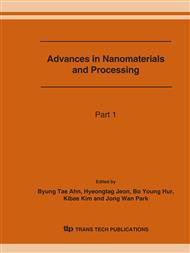p.887
p.891
p.895
p.899
p.903
p.907
p.911
p.915
p.919
The Selective Protein Separations with Polyaminofunctionality on Controlled Silica Coating-Layers of Magnetic Nanoparticles
Abstract:
This work reported the development of the high throughput protein separation process with molecularly assembled silica-coated magnetic nanoparticles as a function of amino group numbers such as mono-, di-, and tri-aminofunctionality, in which the range of silica coating thicknesses were optimized to be interacted with protein. The protein separation efficiency was demonstrated as a function of each aminofunctional group and the particle sizes of the silica coated magnetic nanoparticles. The particles were prepared by the chemical precipitation of Fe2+ and Fe3+ salts with a molar ratio of 1:2 under basic solution. The silica coated magnetic nanoparticles were directly produced by the sol-gel reaction of a tetraethyl orthosilicate (TEOS) precursor, in which the coating layer serves as a biocompatible and versatile group for further biomolecular functionalization. To effectively capture the proteins, silica coated magnetic nanoparticles need to be functionalized reproducibly on the silica surface, and three kinds of amino functional groups were adapted as a function of number of amine using the mono-, di-, and tri-aminopropylalkoxysilanes.
Info:
Periodical:
Pages:
903-906
Citation:
Online since:
June 2007
Authors:
Keywords:
Price:
Сopyright:
© 2007 Trans Tech Publications Ltd. All Rights Reserved
Share:
Citation:


